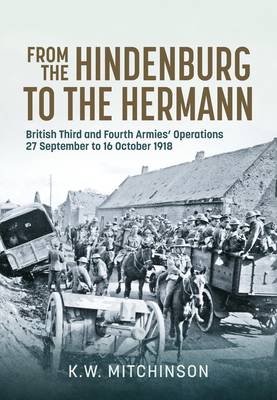
- Retrait en 2 heures
- Assortiment impressionnant
- Paiement sécurisé
- Toujours un magasin près de chez vous
- Retrait gratuit dans votre magasin Club
- 7.000.0000 titres dans notre catalogue
- Payer en toute sécurité
- Toujours un magasin près de chez vous
From the Hindenburg to the Hermann
British Third and Fourth Armies' Operations; 27 September to 16 October 1918
K W Mitchinson
76,45 €
+ 152 points
Description
From the Hindenburg to the Hermann is an analytical narrative of British Third and Fourth Armies' autumn operations between the rivers Escaut and Selle.
Several less formidable yet still substantial German lines of defence lay to a depth of nearly five miles east of the Hindenburg System. Protected by wire belts and registered artillery their trenches and strong points had to be assaulted and broken before an area of open terrain beyond was reached. Once these systems were secured, British, American and Australian forces would have the opportunity of advancing for several miles through still undamaged villages and across gently undulating land. On reaching the Selle they were confronted by the trenches and wire of the Hermann Line.
Despite facing an increasingly effective system of all-arms warfare involving overwhelming Allied firepower and limited mechanisation, many of the withdrawing German forces maintained a dogged and determined resistance. Allied tempo and momentum were maintained but the enemy's continued resolution caused heavy casualties among the advancing infantry. When the armies reached the Selle the losses, unit fatigue, and sustainment difficulties necessitated an operational pause. Time was needed to regroup and prepare for a set-piece battle.
By examining and describing the engagements in one volume illustrated with maps and photographs, From the Hindenburg to the Hermann offers a reference and practical touring guide to these important but little-understood actions. Only a short drive from Cambrai and St Quentin, the area is within easy reach for those visiting the battlefields of the Somme or Arras.
Several less formidable yet still substantial German lines of defence lay to a depth of nearly five miles east of the Hindenburg System. Protected by wire belts and registered artillery their trenches and strong points had to be assaulted and broken before an area of open terrain beyond was reached. Once these systems were secured, British, American and Australian forces would have the opportunity of advancing for several miles through still undamaged villages and across gently undulating land. On reaching the Selle they were confronted by the trenches and wire of the Hermann Line.
Despite facing an increasingly effective system of all-arms warfare involving overwhelming Allied firepower and limited mechanisation, many of the withdrawing German forces maintained a dogged and determined resistance. Allied tempo and momentum were maintained but the enemy's continued resolution caused heavy casualties among the advancing infantry. When the armies reached the Selle the losses, unit fatigue, and sustainment difficulties necessitated an operational pause. Time was needed to regroup and prepare for a set-piece battle.
By examining and describing the engagements in one volume illustrated with maps and photographs, From the Hindenburg to the Hermann offers a reference and practical touring guide to these important but little-understood actions. Only a short drive from Cambrai and St Quentin, the area is within easy reach for those visiting the battlefields of the Somme or Arras.
Spécifications
Parties prenantes
- Auteur(s) :
- Editeur:
Contenu
- Nombre de pages :
- 240
- Langue:
- Anglais
- Collection :
Caractéristiques
- EAN:
- 9781804519769
- Date de parution :
- 15-06-26
- Format:
- Livre relié
- Format numérique:
- Genaaid
- Dimensions :
- 171 mm x 248 mm

Seulement chez Librairie Club
+ 152 points sur votre carte client de Librairie Club
Les avis
Nous publions uniquement les avis qui respectent les conditions requises. Consultez nos conditions pour les avis.






